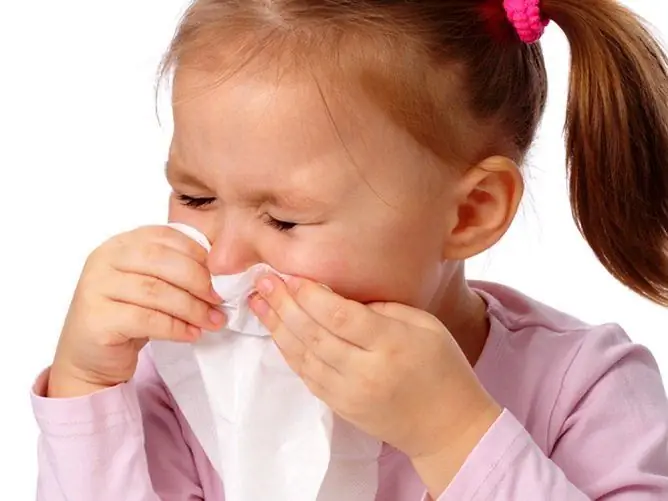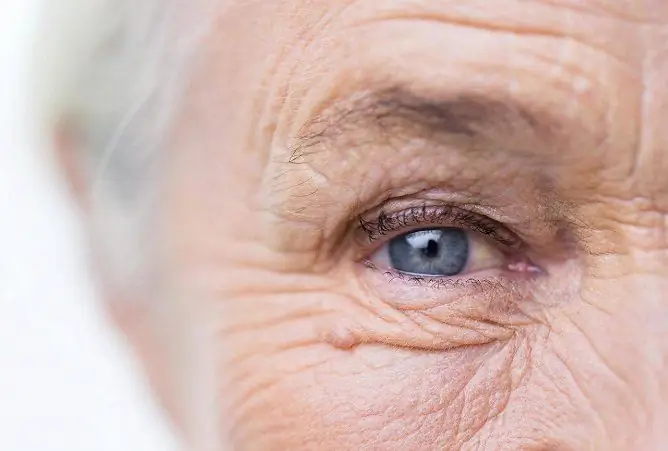- Author Rachel Wainwright [email protected].
- Public 2023-12-15 07:39.
- Last modified 2025-11-02 20:14.
Pressure rate in adolescents by age: how much pressure should be in children 12 years of age and older
The content of the article:
- What determines the pressure of a teenager
- Normal blood pressure in children and adolescents
- How to measure blood pressure in a child
- Causes of pathological pressure in children
- Video
The rate of pressure in a teenager is somewhat different from that of an adult, moreover, the rate is set by the range, and within the range it is different for each person. It is necessary to know the rate of your own pressure for two reasons - firstly, you should measure the pressure from time to time without any signs of pathology in order to know the individual rate. Secondly, blood pressure (BP) can rise without any pronounced symptoms; to detect hypertension, it is measured and compared with an earlier established norm.

The pressure in a teenager normally differs little from the pressure in an adult
The individual rate depends on many indicators, including the state of the body, gender and age.
What determines the pressure of a teenager
A child's body functions in the same way as an adult, but with a number of differences. Metabolic processes are faster, cells also divide much faster and require more blood and nutrients. This requires more intense circulation - a child's heart beats faster than an adult's, which is reflected in the pulse rate, which is higher in children than in adults.
There are two pressure indicators - systolic (upper) and diastolic (lower), and each of them reflects certain parameters.
The upper, systolic pressure, depends on the contractions of the heart. The more the heart muscle contracts, the more blood is thrown into the aorta and the stronger the pulse wave. At the same time, the pressure increases. Since there are not so many muscle elements in a child's heart as in an adult's heart, and also due to the immaturity of the cardiac conduction system at an early age and the absence of compensatory hypertrophy obtained during life, this indicator in children is usually lower than in adults. This is important to understand that if a child has low blood pressure, this is not a cause for concern, such indicators are normal for children of a certain age. Conversely, you can skip hypertension in a child, if you measure it in the framework of adults.
The lower pressure is called diastolic and depends on:
- kidney and excretory system. The kidneys regulate the amount of urine output and the volume of circulating blood. If, for some reason, the functional insufficiency of this organ does not filter, the volume of blood in the stream increases, the pressure increases. This also has the opposite effect - massive diuresis leads to a drop in pressure (and is also fraught with an imbalance in electrolytes);
- endocrine system. There are several hormonal systems that control blood pressure. These include the renin-angiotensin system, which has a decisive effect on peripheral vascular tone, the adrenal system, the hormones vasopressin and aldosterone. Some act on vascular tone, some on electrolytes (sodium, potassium, calcium, chlorine);
- nervous system. Constant and rapid regulation is performed by the autonomic nervous system. It maintains peripheral vascular tone by providing venous blood flow to the heart. In the vessel wall there are many smooth muscle elements, which, by contracting, push the blood further and further. These stimuli are delivered by subcortical centers. The heart muscle also needs the same regulation.
Thus, from these two numbers, the blood pressure indicator is formed, which is normally in the range of 110-120 / 70-80 mm Hg. Art. (millimeters of mercury).
Normal blood pressure in children and adolescents
Normal blood pressure readings in a child may not resemble books, therefore, formulas have been developed to calculate the pressure, which is considered optimal in childhood. They look like this:
- up to one year of life - 76 + 2 x T (where T is the months of the child's life) for systolic, while the diastolic is from 1/2 to 2/3 of the systolic;
- older than one year of life - 90 + 2 x T (where T is the child's age in years) for the upper pressure, and the lower one will be 60 + T. For example, the pressure rate in children 10 years old will be 110 to 70 mm Hg. Art.
Using the formulas, it is easy to calculate the correct pressure level. Approximate figures for all ages, taking into account time fluctuations and age characteristics, are given below.
Up to 2 weeks of life - 60-96 by 40-50 mm Hg. Art. This is not low blood pressure, as is commonly believed, the fact is that the heart muscle of children of this age is not yet mature enough, and the composition of the blood contains a lot of young hemoglobin, which is characteristic only of such small children and is practically absent in the body of an adult. The pulse in newborns is very fast, but the cardiac output is not strong, so the pressure does not rise.
2-4 weeks of life - the strength of the heart muscle increases, but the child's needs for oxygen and nutrition also increase, so the pressure increases to 80-112 by 50-74 mm Hg. Art.
Up to a year, the child is growing rapidly, and with it the heart - now the pressure is 90-115 to 60-75 mm Hg. Art.
3-6 years - the pressure is what is necessary for the successful provision of a growing organism. The numbers reach 110-115 at 65-75 mm Hg. Art. It becomes noticeable that the lower end of the range is shrinking, this is characteristic of a growing heart muscle.
6-12 years is an important time for the body, closer to the end of this time period of life, a total restructuring of everything begins in connection with the puberty period, and these changes cannot but affect the pressure. At this time, gender differences arise in the blood pressure indicator - the pressure in boys and girls from this period will differ. The normal pressure in a child of 11 years old is 115-120 by 70-80 mm Hg. Art., that is, reaches adult values.
From the age of 13 to 15 - at this age, hormonal changes continue, but the pressure does not normally increase. High blood pressure during this period may be due to emotional stress, increased mental work, an inactive lifestyle. The pressure norm in a 14-year-old adolescent is the same as in an adult, its upper limit is 120 to 80 mm Hg. Art., and everything above may be a manifestation of full-fledged hypertension with a complete symptom complex.
At the age of 16, 17, a lot of estrogen is synthesized in the body of girls - a female sex hormone that has a vasodilating effect and lowers blood pressure. Therefore, some hypotension (persistent low blood pressure) is a common condition for girls, and guys at this age are more likely to experience symptoms of hypertension. This situation persists until the cessation of estrogen synthesis - menopause, when parity is established.
How to measure blood pressure in a child
If a child complains of poor health, dizziness, weakness, insomnia, he has a deterioration in concentration, memory, if he experiences mood swings, is aggressive or hot-tempered, talks about headaches, his blood pressure should be measured in order not to miss a serious pathology.
There are several rules that must be followed:
- The cuff of the tonometer should fit snugly against the arm and not sag. In addition, it should not cover the arm several times, the arm circumference should be 80-100% of the cuff length, otherwise the indicators will not be accurate. Therefore, you should use a special baby cuff, which is often supplied with the tonometer.
- Measurement should be performed correctly three times on each hand with an interval of 3-5 minutes. After measurement, the average is determined, and it indicates the correct pressure level.
- The best time to take regular blood pressure measurements is in the morning after waking up and in the evening before bed.
- The child should be calm, there is no need to measure pressure after a hearty meal, during a walk or after it, running, active games, crying. This is not the right time, the resulting figure will not be objective. It is necessary to reassure the child, explain that it is not painful and useful, to interest him. The measurement should be preceded by half an hour of quiet sitting or some kind of leisurely entertainment.
- It is not necessary to put the cuff on clothes, even thin ones - this knocks down the indicators of the device, prevents measurement.
- The measurement is carried out in a sitting position (for infants, it is also allowed in a supine position), while the cuff should be located at the same level with the heart, and the cuff tube should be parallel to the radial artery.
- If the tonometer is not mechanical, do not hold the pear in your hands while deflating and counting the numbers on the device screen - the pulsation of the arteries in the hand can knock the device down and the result will be incorrect.
By observing these rules, you can get an accurate result. Often there is no need to carry out it yourself - a doctor can do it, acting according to the protocol and with maximum accuracy.
Causes of pathological pressure in children
So, what pressure should be in children 12 years old, 13 years old, 14 years old and so on, we found out. Now let's talk about what may be the reason for the deviation of blood pressure from the norm.
An increase in blood pressure in children can cause:
- emotional stress (the most common cause of hypertension in children, especially in emotionally labile children);
- intense physical activity (active games, running) and some time after it;
- painful sensations (falls, injuries);
- as well as diseases of the kidneys, endocrine glands, cardiovascular system (secondary hypertension).
Primary hypertension in children is mild, that is, it rarely has severe symptoms.

Only a doctor should diagnose and prescribe treatment when blood pressure deviates from the norm.
Low blood pressure in a child occurs with severe fatigue, lack of sleep, lack of regular physical activity (later this condition can lead to hypertension, if it is prolonged), infectious diseases (especially in chronic form), allergies, taking certain drugs, helminthic invasions, violation of the regimen sleep and wakefulness.
Noticing any deviation of pressure from the age norm, in no case should you correct it yourself, especially “adult” antihypertensive drugs are especially dangerous for children. It is necessary to consult a doctor who will conduct an examination, find out the exact cause of the pathology and, if necessary, prescribe treatment.
Video
We offer for viewing a video on the topic of the article.

Nikita Gaidukov About the author
Education: 4th year student of the Faculty of Medicine No. 1, specializing in General Medicine, Vinnitsa National Medical University. N. I. Pirogov.
Work experience: Nurse of the cardiology department of the Tyachiv Regional Hospital No. 1, geneticist / molecular biologist in the Polymerase Chain Reaction Laboratory at VNMU named after N. I. Pirogov.
Found a mistake in the text? Select it and press Ctrl + Enter.






